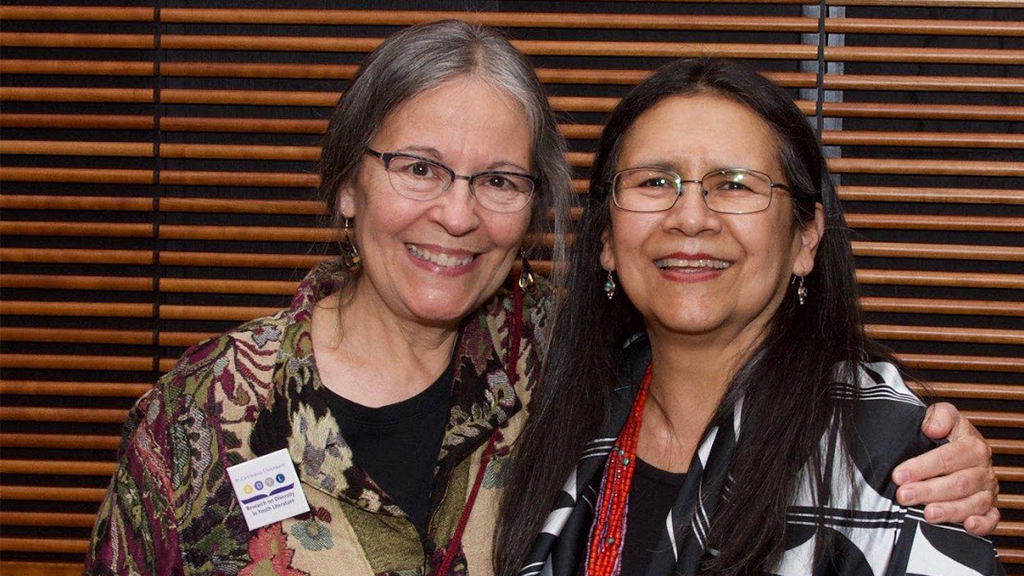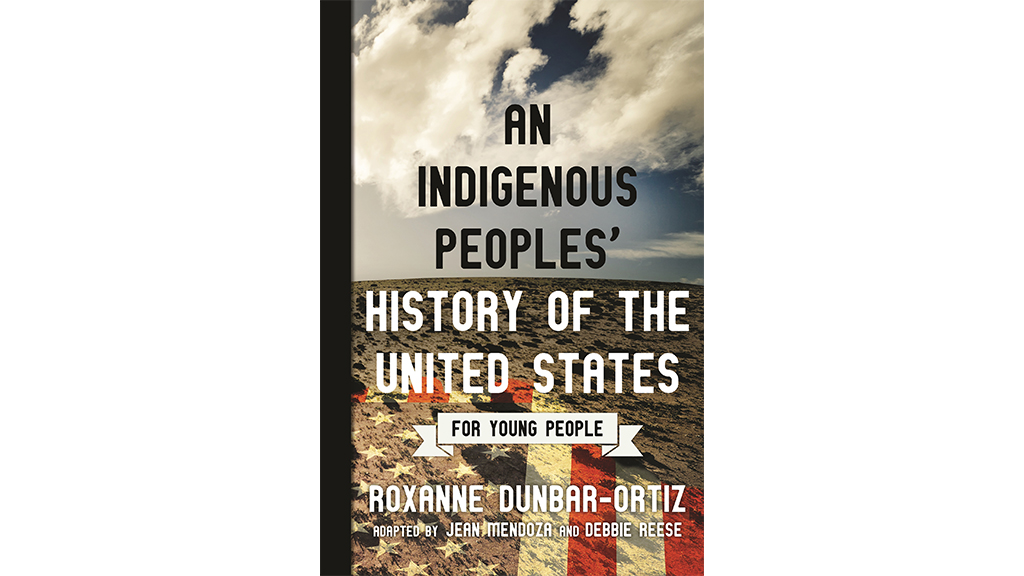
Longtime collaborators Jean Mendoza and Debbie Reese. (Photo credit: Durango Mendoza)
Veteran educators and curriculum specialists Jean Mendoza and Debbie Reese say that adapting Roxanne Dunbar-Ortiz’s award-winning book—An Indigenous Peoples’ History of the United States—for middle-grade and young adult readers was at times emotionally and intellectually exhausting. “Early on, we began to feel the weight” of helping young readers grasp the “brutality of colonization” and the power of the ongoing Indigenous resistance, says Reese, a tribal member of Nambé Pueblo. “A fuller recognition of that resistance” is essential because young people, Native and non-Native, “NEED to know these things,” Mendoza says.
In an email exchange with ASBJ’s Michelle Healy, the authors discuss writing An Indigenous Peoples’ History of the United States for Young People (Beacon Press), adding discussion topics and activities, archival images and maps, and a recommended reading list, and accurately placing the story of Indigenous peoples in classroom instruction.

Dunbar-Ortiz’s historical text is very clear about the violence inflicted on Native peoples. How did you approach that, given your adolescent audience?
Reese: We hope that we conveyed the brutality of colonization in ways that respect the well-being of young people, especially Native youth, and that do not affirm stereotypical imagery of “primitive” or “savage” Indians that are common in most history books. We see that stereotypical imagery in the “Life of Washington” Arnautoff mural at George Washington High School in San Francisco. While we understand that people view the mural as historically significant, we believe the stereotypical images do more harm than good to all students in that school. (In July, the San Francisco Unified School District Board of Education voted unanimously to remove from public view and permanently cover Victor Arnautoff’s long-debated 13-panel painting.)
Mendoza: The emotional component was very hard. So many incidents involved brutalization of Indigenous families, even children, by colonizer forces, and those were especially hard to stomach, hard to move on from. Also, the genocidal colonizer vision of forcing Indigenous people out of their homelands, which played out in so many ways and continues to this day – there were times when the staying power of that vision and its utter inhumanity could just lay a person low. It was important at those times to focus on the multigenerational, ongoing Indigenous resistance.
Reese: In 1680 the Pueblo Revolt drove the Spanish out of my homelands. My ancestors were part of that revolt. They fought against a larger force, for what we, the Pueblo Peoples, have today. In turn, I fight for what we have and for what I want Pueblo children to have, in their future.
You examine Native American experiences of the past and the present, such as the Dakota Access Pipeline protests. What messages do you hope readers take away?
Mendoza: Indigenous sovereignty. Resistance. Resilience. You can’t have a full discussion of Indigenous experiences, from pre-1492 to the present, without keeping those realities in mind. Also, “the past is present.” The book talks about Andrew Jackson, who benefited from enslaved labor and who became president partly because of his reputation as a killer of Indigenous people. A portrait of Jackson was recently installed in the White House because the new occupant so greatly admires him. Also, during the (Pipeline) protests, the rhetoric coming from law enforcement mirrored things that were said about Native people 150-300 years earlier. And their actions also echoed the heavily militarized campaigns against Native people who were trying to protect their homelands and their resources. Debbie mentioned the problems with those murals in the San Francisco high school. Teachers can make sure students understand such long-running threads in U.S. history.
Reese: To bring a critical lens to everything. We were adapting the book during an uncritical embrace of “Hamilton, the Musical.” Teachers were and are taking students to see it, but author Lin Manuel Miranda chose not to include us, at all! So, the “history” students take from it is far from acceptable. In our adaptation we invite readers to revise the musical with information they got from our book. How, we wonder, might students correct Miranda’s omissions? A second message: We were nations before the U.S. was a nation. Treaties are diplomatic negotiations between heads of state. Their existence is evidence that colonizing Europeans recognized us as nations.
As founder of the blog American Indians in Children’s Literature (AICL), Debbie often raises concerns about the tiny sliver of books published annually about Indigenous peoples and culture. Besides quantity, what are some other book-related issues that schools should pay attention to?
Mendoza: Books that place Native people only in the past, dressed in leather and feathers, talking fractured English or using very poetic-sounding speech. Books that lump all Native people together regarding histories, governance, language, traditions, clothing, homes, stories. Books that relentlessly center on the experiences of white colonizers, settlers, and descendants, making Native people’s experiences in their homelands tangential. No teacher or parent in their right mind would offer books that insist on teaching that 2+2 = 5. Books with misinformation and bias regarding Indigenous people are just as wrong, have a similar negative effect on children’s ability to understand the world, and should be avoided in any school or classroom library. No matter how beloved or “classic” they are. They miseducate all children and place an undue burden on Native kids.
Reese: Whether primitive or noble, stereotypical imagery in classic, award-winning, and popular children’s books miseducates all children, and has a detrimental long-term effect. Some young people carry that imagery into their work as book editors who reject manuscripts from Native writers because Native-authored stories aren’t “Indian enough.” Some young people carry that imagery into their work in the U.S. Congress and the White House where they create laws and make statements that are detrimental to the well-being of Native youth. In addition, there’s a belief that our traditional stories are “folk” rather than religious stories that ought to receive the same respect that Bible stories receive.
November is National Native American Heritage Month. Any advice?
Mendoza: First and foremost, don’t do it just during that one month. Second, never assume that you have no Native kids in your classroom. Third, make sure all teachers and students recognize that Indigenous peoples were thriving in what are currently called the Americas long before any Europeans came here. This. Was. Their. Home. Make sure they understand that this fact was not accepted by Europeans and by those who founded the U.S. on Native homelands. We’d like to see teachers stop using materials for young people that contain bias, stereotypes, or other misrepresentation of Native people. We’d like to see educators retire books like They Were Strong and Good, The Matchlock Gun, Island of the Blue Dolphins, Brother Eagle Sister Sky, and Little House on the Prairie – replacing them with engaging books by Native writers.
Should Native American studies curricula be required?
Reese: I’d like to see more schools – and more states – mandating that Native curriculum be brought to their students. Montana’s Indian Education for All is one example of a state that is educating students in a just way. There’s no excuse for anybody not knowing the names of the Native Nations on whose homeland they stand on and where the peoples of those nations are, today. If school boards asked their pre-k through 12th-grade teachers to begin every lesson on Native peoples with present tense verbs, it could make a difference for all students and people in the school community. Eventually, we won’t have to remind people that we’re here.

Share this content